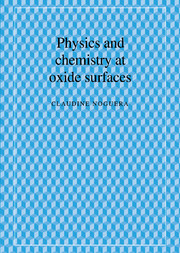2 - Atomic structure of surfaces
Published online by Cambridge University Press: 24 September 2009
Summary
When a crystal is cut along some orientation, the atoms located in the few outer layers experience non-zero forces which are induced by the breaking of oxygen–cation bonds. Generally, they do not remain at the positions fixed by the three-dimensional lattice. Point or extended defects may result, as well as lattice distortions. This chapter analyses the structural features of oxide surfaces, which is also a useful step, before starting the discussion of the surface electronic properties. Yet, conceptually, this presentation is not fully satisfactory, because the structural and electronic degrees of freedom are coupled and both determine the ground state configuration. Despite a rich literature, the structural properties of oxide surfaces are not fully elucidated. It is often difficult to prepare stoichiometric and defect-free surfaces, and the characterization is hindered by charging effects and by an uncertainty about the actual crystal termination.
Preliminary remarks
We will make some preliminary remarks concerning the designation of the surfaces, their polar or non-polar character and their structural distortions – relaxation, rumpling and reconstruction.
Notations
A plane in a crystal, is identified by three integers (h, k, l), called the Miller indices, which are in the same ratio as (1/x, 1/y, 1/z), the inverses of the coordinates of the intersections of this plane with the crystallographic axes (van Meerssche and Feneau-Dupont, 1977). Notations with four indexes (h, k, –(h + k), l) are used in hexagonal structures, such as α-quartz, corundum α-alumina, or the wurtzite ZnO structure.
- Type
- Chapter
- Information
- Physics and Chemistry at Oxide Surfaces , pp. 42 - 67Publisher: Cambridge University PressPrint publication year: 1996



